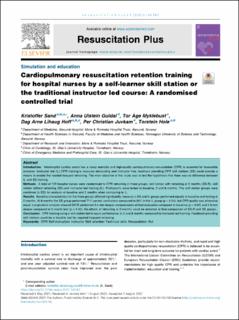| dc.contributor.author | Sand, Kristoffer Øksenvåg | |
| dc.contributor.author | Guldal, Anna Ulstein | |
| dc.contributor.author | Myklebust, Tor Åge | |
| dc.contributor.author | Hoff, Dag Arne Lihaug | |
| dc.contributor.author | Juvkam, Per Christian | |
| dc.contributor.author | Hole, Torstein | |
| dc.date.accessioned | 2023-01-23T09:31:28Z | |
| dc.date.available | 2023-01-23T09:31:28Z | |
| dc.date.created | 2021-12-23T12:37:08Z | |
| dc.date.issued | 2021 | |
| dc.identifier.citation | Resuscitation Plus. 2021, 7 1-6. | en_US |
| dc.identifier.issn | 2666-5204 | |
| dc.identifier.uri | https://hdl.handle.net/11250/3045189 | |
| dc.description.abstract | Introduction
Intrahospital cardiac arrest has a steep mortality and high-quality cardiopulmonary resuscitation (CPR) is essential for favourable outcome. Instructor led (IL) CPR training is resource demanding and instructor free, feedback providing CPR skill stations (SS) could provide a means to enable the needed frequent retraining. The main objective of this study was to test the hypothesis that there was no difference between IL and SS training.
Methods
A total of 129 hospital nurses were randomised to CPR retraining in three groups; skill station with retraining at 2 months (SS-R), skill station without retraining (SS) and instructor led training (IL). Participants were tested at baseline, 2 and 8 months. The skill station groups were combined (c-SS) for analysis at baseline and 2 months when comparing to IL.
Results
Baseline characteristics for the three groups differed significantly, however c-SS and IL groups performed equally at baseline and testing at 2 months. At 8 months the SS group performed 71% correct ventilations compared to 54% in the IL group (p = 0.04), but CPR quality was otherwise equal. Longitudinal analysis showed SS-R performed 3.4 mm deeper compressions at final evaluation compared to baseline (p = 0.02) and 2.8 mm deeper compared to 2-month test (p = 0.02). No effects of retraining at 2 months could be detected at final comparison of SS-R and SS groups.
Conclusion
CPR training using a skill station led to equal performance at 2 and 8 months compared to instructor led training. Feedback-providing skill stations could be a feasible tool for required frequent retraining. | en_US |
| dc.language.iso | eng | en_US |
| dc.publisher | Elsevier Science | en_US |
| dc.relation.uri | https://www.sciencedirect.com/science/article/pii/S2666520421000825 | |
| dc.rights | Navngivelse 4.0 Internasjonal | * |
| dc.rights.uri | http://creativecommons.org/licenses/by/4.0/deed.no | * |
| dc.title | Cardiopulmonary resuscitation retention training for hospital nurses by a self-learner skill station or the traditional instructor led course: A randomised controlled trial | en_US |
| dc.title.alternative | Cardiopulmonary resuscitation retention training for hospital nurses by a self-learner skill station or the traditional instructor led course: A randomised controlled trial | en_US |
| dc.type | Peer reviewed | en_US |
| dc.type | Journal article | en_US |
| dc.description.version | publishedVersion | en_US |
| dc.source.pagenumber | 1-6 | en_US |
| dc.source.volume | 7 | en_US |
| dc.source.journal | Resuscitation Plus | en_US |
| dc.identifier.doi | 10.1016/j.resplu.2021.100157 | |
| dc.identifier.cristin | 1971739 | |
| dc.source.articlenumber | 100157 | en_US |
| cristin.ispublished | true | |
| cristin.fulltext | original | |
| cristin.qualitycode | 1 | |

